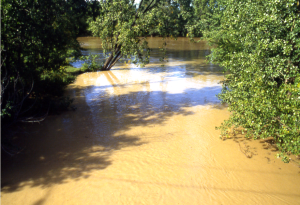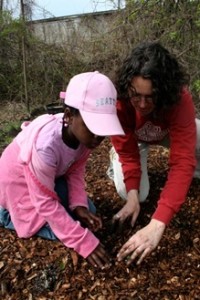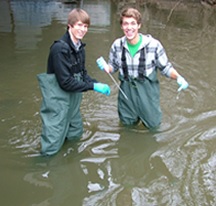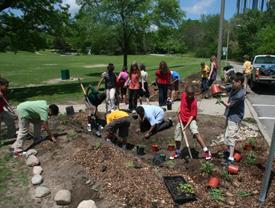The Setting
Plaster Creek is a 14 mile-long stream that drains a watershed covering approximately 58 square miles, in metropolitan Grand Rapids, Michigan. The creek initially flows through agricultural lands, then commercial and residential areas, and finally an industrial zone and low-income neighborhoods before emptying into the Grand River.
the Grand River.
Major water quality problems include sediment from stormwater runoff which causes flooding and erosion (destroying habitat for aquatic life); dangerously high levels of E. coli, including several strains of antibiotic resistant bacteria; excess nutrients from lawn and agricultural fertilizers; runoff from warm, paved surfaces causing creek temperatures to fluctuate dramatically, making it inhospitable for aquatic wildlife; and untreated urban runoff, industrial waste, and road salt. In the 1850s, gypsum was mined from the banks of the stream and used to produce plaster utilized for construction of the newly developing city of Grand Rapids. Pollution from the mining caused the creek to run white, which led to a change in the name from Ken-O-Sha (“Water of the Walleye”) to Plaster Creek. Unfortunately, this rather ugly name has persisted to the present day.
Research + Education + Action = Community Engagement for Watershed Restoration
Conducting good research in order to understand problems and then being able to take action to solve those problems is powerful—and in a college setting, a critical lesson. Plaster Creek Stewards—a program of Calvin College—integrates these elements into interesting, educational, and effective projects that benefit students, the community, the Plaster Creek watershed, and ultimately, the Grand River and Lake Michigan.
In 2004, several faculty members with an interest in the degraded Plaster Creek wondered whether they could provide an educational experience and working laboratory to enhance student education and provide real benefit to the creek. They began their program with research and education being key, and—as Calvin College is highly encouraging of service-learning and hands-on-experience—they also launched an on-the-ground restoration initiative.
Highlights of their integrated approach:
Upstream-down stream connections: In the Plaster Creek watershed, downstream creek health is heavily impacted by upstream watershed uses. So an important part of the Stewards’ work has been to create partnerships and connections between churches, schools, and organizations from both ends of the watershed. For example, two schools – one upstream and one downstream – are combining both their 3rd and 8th grade classes for reciprocal visits and a joint watershed tour. Through such an effort students can see what is happening to the creek in both upstream and downstream regions. Additionally eighth graders from both schools conduct water quality testing in their area of the watershed, share their data and discuss differences in the health of the creek. Similar programs, such as matching upstream and downstream church youth groups to learn about stormwater and to work collaboratively on a project in the watershed, are also underway. These partnerships identify and begin to address issues of environmental justice that are present in this urban watershed.
stream connections: In the Plaster Creek watershed, downstream creek health is heavily impacted by upstream watershed uses. So an important part of the Stewards’ work has been to create partnerships and connections between churches, schools, and organizations from both ends of the watershed. For example, two schools – one upstream and one downstream – are combining both their 3rd and 8th grade classes for reciprocal visits and a joint watershed tour. Through such an effort students can see what is happening to the creek in both upstream and downstream regions. Additionally eighth graders from both schools conduct water quality testing in their area of the watershed, share their data and discuss differences in the health of the creek. Similar programs, such as matching upstream and downstream church youth groups to learn about stormwater and to work collaboratively on a project in the watershed, are also underway. These partnerships identify and begin to address issues of environmental justice that are present in this urban watershed.
Oral histories: Calvin College students have been interviewing community members to collect their stories and memories of experiences with Plaster Creek. As part of their social research courses, this project has provided Plaster Creek Stewards with a deeper understanding of what the watershed used to be like and the changes it has endured over time. These oral histories serve as a foundation for envisioning what the creek can once again become.
Biological research: Student projects led by Calvin College faculty have focused on water quality assessments, the impact of invasive species, as well as the prese nce of environmental estrogens and antibiotic-resistant bacteria. These data will be used to track changes over time as remediation efforts advance. Plaster Creek Stewards also operates a greenhouse to propagate native plants that are used in restoration projects, providing students with ample opportunities to learn not only the life cycles of native plants but also management and maintenance skills used in the nursery industry.
nce of environmental estrogens and antibiotic-resistant bacteria. These data will be used to track changes over time as remediation efforts advance. Plaster Creek Stewards also operates a greenhouse to propagate native plants that are used in restoration projects, providing students with ample opportunities to learn not only the life cycles of native plants but also management and maintenance skills used in the nursery industry.
Annual events: A cornerstone of the outreach effort is an emphasis on combining education and action. Each fall, spring and summer Plaster Creek Stewards hosts a full day workshop open to partner organizations, students, and community members focusing on the health of Plaster Creek. At these workshops educational presentations are followed by opportunities to do hands-on restoration activities. Some past themes for these workshops have included: basic watershed ecology, the importance of trees for a healthy watershed, rain gardens and bio-swales to capture stormwater run-off, native and invasive wildflowers in the watershed. The Stewards have found that this combination of education and action is a powerful strat egy for motivating community engagement in watershed restoration.
egy for motivating community engagement in watershed restoration.
Green infrastructure installations: Since stormwater is a major polluter of Plaster Creek, installing projects that allow stormwater to soak back into the ground and using native plants to stabilize soil and filter runoff are essential to improving water quality. Plaster Creek Stewards staff and volunteers install various green infrastructure projects each year, using native plants that are grown from locally collected seeds in Calvin College’s greenhouse and tree nursery. This work is supported by a combination of grant funding and fee-for-service arrangements.
Youth green team: In 2013, Plaster Creek Stewards launched a summer high school program to connect local urban youth to Calvin College, to teach them about watershed ecology and provide them with paid summer jobs installing green infrastructure projects. In 2014, the Stewards received their second EPA Urban Waters Small Grant of $60,000 to expand the program.
Lessons Learned
- Combine education with action. Plaster Creek Stewards’ program is based on understanding and doing. One without the other doesn’t provide the long-term benefits of stewardship.
- Build partnerships. While it seems like a lot of work to coordinate partners, the payoff is that more people are involved and take ownership of a project, there are more creative ideas, and community members can see their efforts multiplied. t helps to have a strategic plan! Even a four-pager helps you say “yes” and “no.” It’s very important to be able to keep focus when there are so many things to do.
- Connection to a college provides beneficial opportunities. While Plaster Creek Stewards is based entirely in the college, collaborating with professors and student programs for non-college-based programs allows for opportunities to conduct research, reach student volunteers, and oftentimes access free expertise.

